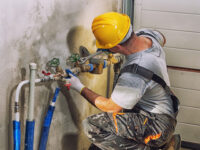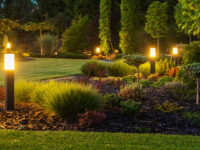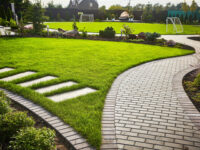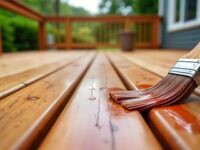The Essential Guide to Siding Installation: Enhancing Your Home’s Durability and Appeal
Siding Installation Murfreesboro TN is an integral part of any home construction or renovation project. It not only plays a major role in improving the aesthetics of a house but also protects it from the harsh elements.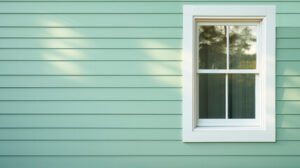
Homeowners often overlook the significance of siding, but it serves a crucial purpose in maintaining the integrity of a structure. Whether building from scratch or updating an existing property, the choice of siding material and installation process can make a lasting impact on the overall quality of a home.
The first step in siding installation involves selecting the right material. There is an array of options to choose from, including wood, vinyl, fiber cement, and metal, each offering unique benefits and aesthetics. The choice of material depends on factors like budget, climate, and desired maintenance levels. Each type of siding has its pros and cons, so it’s important to evaluate the long-term costs, appearance, and performance before making a decision.
Once the material is chosen, preparation is key to a successful siding installation. The walls of the home must be thoroughly inspected for any existing damage, moisture issues, or gaps that could affect the performance of the siding. If the structure is not properly prepared, the siding may not adhere well or may develop issues down the road, such as leaks or mold growth. Repairing these issues before installing the siding ensures a smooth, effective installation process.
During installation, the siding material must be cut to size and attached securely to the exterior of the home. Depending on the type of siding, this may involve nailing or screwing the material into place. Proper alignment is essential to achieve a clean and uniform look, as well as to ensure that the siding performs its protective function. Installers must take precise measurements and pay attention to every detail to guarantee a flawless finish.
One of the most important aspects of siding installation is weatherproofing. To prevent moisture from seeping into the walls and causing damage, a weather-resistant barrier is often applied before the siding is installed. This barrier serves as an extra layer of protection against rain, snow, and humidity, ensuring that the home remains dry and insulated. Additionally, proper sealing around windows and doors helps prevent air leaks and drafts, enhancing the energy efficiency of the building.
The installation process also includes trimming the edges of the siding to create a neat, finished appearance. Special care must be taken around corners, joints, and rooflines to ensure that the siding fits perfectly. This step requires skill and experience, as improper trimming can lead to unsightly gaps or uneven lines that detract from the home’s overall appearance. Skilled contractors take the time to measure and cut each piece with precision, ensuring that all edges are clean and smooth.
Once the siding is installed, the final step is to inspect the work and make sure everything is properly secured. Installers check for any loose boards or nails that could cause problems later. They also ensure that all seams are sealed and that the siding is free from defects such as warping, discoloration, or cracks. This final inspection guarantees that the siding will provide both visual appeal and long-lasting protection.
In addition to installation, regular maintenance is essential to prolong the life of siding. Over time, siding may become dirty or discolored due to exposure to the elements. Regular cleaning can help maintain its appearance and prevent the buildup of dirt, mold, or mildew. Homeowners should also inspect their siding periodically for signs of damage, such as cracks, dents, or missing pieces, and address these issues promptly to avoid more costly repairs in the future.
Siding installation can also be influenced by the local climate. For example, in areas that experience high humidity or frequent rainfall, moisture-resistant materials like fiber cement or vinyl are ideal choices. In regions with extreme temperatures, insulated siding options may help improve energy efficiency by keeping the home warmer in winter and cooler in summer. A contractor experienced in local climate conditions can guide homeowners in selecting the most suitable materials for their environment.
The cost of siding installation varies depending on several factors, including the type of material chosen, the size of the home, and the complexity of the installation. While some materials may have a higher upfront cost, they often provide better long-term value due to their durability and low maintenance needs. Homeowners should consider both the initial investment and the long-term savings when making their decision. Proper installation ensures that the siding will continue to perform well for many years, providing value for money over time.
The role of professional contractors in siding installation cannot be overstated. While DIY installations may seem like a cost-effective option, the expertise and experience of a qualified contractor can make a significant difference in the final result. Professional installers have the tools, knowledge, and skills to handle even the most complex installations with precision. Hiring a contractor also ensures that the work is completed on time, meets building codes, and comes with a warranty for added peace of mind.
Some homeowners may choose to install their own siding as a way to save money, but this is often not recommended unless they have experience in construction and the proper tools. Incorrect installation can lead to problems such as water damage, insulation issues, or even structural damage. For example, poorly installed siding may allow moisture to seep into the walls, which can lead to mold growth and rot. For the best results, it’s generally advisable to hire professionals who are trained in the specific requirements of siding installation.
Siding installation not only enhances the look of a home but can also increase its value. A well-maintained exterior creates a positive first impression, making a home more attractive to potential buyers. Whether the goal is to improve curb appeal or increase resale value, siding can be an excellent investment. Choosing the right material and ensuring proper installation are key to achieving the desired results.
The environmental impact of siding materials is another consideration for homeowners. Some materials, such as vinyl, may have a higher environmental footprint due to the manufacturing process and the chemicals involved. However, newer eco-friendly options, such as insulated siding or recycled materials, provide sustainable alternatives. Homeowners who are environmentally conscious should consult with contractors about the most eco-friendly siding options available.
In addition to aesthetics and functionality, siding plays a crucial role in the overall energy efficiency of a home. Insulated siding options are designed to reduce energy loss by providing an extra layer of insulation. This can help lower heating and cooling costs, making the home more energy-efficient and comfortable year-round. Siding that is properly installed and sealed contributes to better insulation, which in turn helps reduce the home’s carbon footprint.
Siding installation can also have an impact on the overall maintenance and upkeep of a property. Some materials, such as wood, require more frequent maintenance, including painting, sealing, and repairs. On the other hand, materials like vinyl and fiber cement are more durable and require less maintenance. Homeowners should consider how much time and effort they are willing to dedicate to maintaining their siding when choosing the right material for their needs.
In some cases, siding installation is part of a larger home renovation project. Homeowners may choose to update their siding as part of a remodel or expansion, especially if they are looking to modernize the look of their home. Siding can be an easy way to enhance the appearance of an older home or to update the exterior of a home that is part of a new development. Regardless of the reason for the installation, proper planning and professional assistance ensure a smooth process and successful outcome.
Finally, siding installation is not just about the material; it’s also about choosing the right style and color. The color of the siding can greatly influence the overall look of the home, and it should complement the surrounding landscape and architectural style. Contractors can offer guidance on color choices based on the home’s design and the homeowner’s preferences. Choosing the right color and finish helps create a cohesive, inviting exterior that enhances the home’s curb appeal.
In conclusion, siding installation is an essential part of any home construction or renovation project. It protects the structure from the elements while adding to its aesthetic appeal. Whether choosing wood, vinyl, or other materials, proper installation is key to achieving both beauty and durability. A well-installed siding system can improve the energy efficiency of the home and increase its value. While the cost of installation may vary, the benefits it offers in terms of protection, insulation, and curb appeal make it a worthwhile investment for any homeowner.

